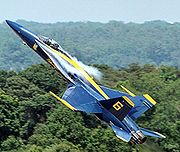
Strake (aviation)
Encyclopedia

Aviation
Aviation is the design, development, production, operation, and use of aircraft, especially heavier-than-air aircraft. Aviation is derived from avis, the Latin word for bird.-History:...
, a strake is an aerodynamic
Aerodynamics
Aerodynamics is a branch of dynamics concerned with studying the motion of air, particularly when it interacts with a moving object. Aerodynamics is a subfield of fluid dynamics and gas dynamics, with much theory shared between them. Aerodynamics is often used synonymously with gas dynamics, with...
surface generally mounted on the fuselage
Fuselage
The fuselage is an aircraft's main body section that holds crew and passengers or cargo. In single-engine aircraft it will usually contain an engine, although in some amphibious aircraft the single engine is mounted on a pylon attached to the fuselage which in turn is used as a floating hull...
of an aircraft
Aircraft
An aircraft is a vehicle that is able to fly by gaining support from the air, or, in general, the atmosphere of a planet. An aircraft counters the force of gravity by using either static lift or by using the dynamic lift of an airfoil, or in a few cases the downward thrust from jet engines.Although...
to improve the airflow and hence the flight characteristics.
In general a strake is longer than it is wide, in contrast to a winglet
Winglet
Wingtip devices are usually intended to improve the efficiency of fixed-wing aircraft. There are several types of wingtip devices, and though they function in different manners, the intended effect is always to reduce the aircraft's drag by partial recovery of the tip vortex energy...
or a moustache.
Leading edge root extensions (LERX) are also sometimes referred to as wing strakes.
Usage
Many supersonic jet designs suffer from marginal lateral stability. One or two large strakes are sometimes positioned under the rear fuselage, below the tail empennageEmpennage
The empennage , also known as the tail or tail assembly, of most aircraft gives stability to the aircraft, in a similar way to the feathers on an arrow...
, to provide adequate stability at high angles of attack when the tail fin is shielded from the main airstream by the fuselage. Typical examples can be seen on the Lockheed F-104 Starfighter and the MiG 21.
On both supersonic and subsonic types, smaller strakes are sometimes applied to the forward fuselage or elsewhere to reduce drag and improve predictability at variable angles of attack, for example on the Concorde
Concorde
Aérospatiale-BAC Concorde was a turbojet-powered supersonic passenger airliner, a supersonic transport . It was a product of an Anglo-French government treaty, combining the manufacturing efforts of Aérospatiale and the British Aircraft Corporation...
SST
SST
The acronym SST may refer to:In aircraft and naval vehicles*Scaled Composites SpaceShipTwo*SST class blimp SS class blimp*Supersonic transport , civil aircraft for transporting passengers faster than the speed of sound....
.
Munitions
Certain air-deployed munitions, particularly "dumb" or unguided 500-pound bombs, are often retrofitted with bolt-on strake sets. Designed as an open collar with strakes fitted to the outside face, these strake sets are used to alter and normalize the aerodynamics of the weapon, yielding greater accuracy. As most such munitions were manufactured with only tail-mounted stabilizer fins, the addition of longitudinal strakes proves a much cleaner flow of air around the weapon during its glide, reducing the tendency to yaw and improving terminal accuracy.Strakes are also often found on "smart" or guided munitions as an aid to the guidance system. By stabilizing the slipstream of air traveling over the weapon, the actions of control surfaces are much more predictable and precise, again improving the accuracy of the weapon.

